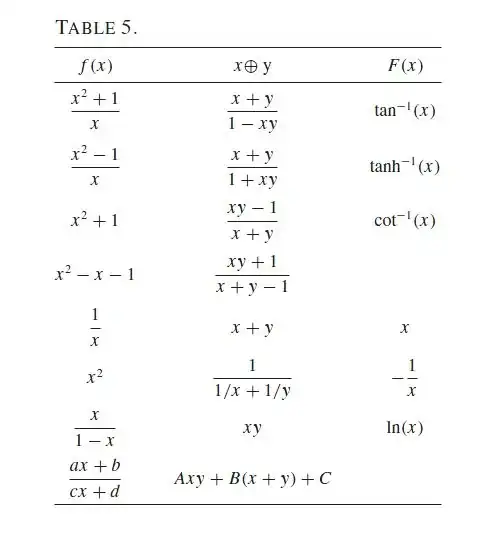$\newcommand{\Dmd}{\diamond}\newcommand{\Reals}{\mathbf{R}}$Perhaps you know this already, but $(\Reals, +)$ is isomorphic to $\bigl((-1, 1), \Dmd\bigr)$ via $\tanh$, i.e.,
$$
\tanh(\alpha + \beta)
= \frac{\tanh \alpha + \tanh \beta}{1 + \tanh \alpha \tanh \beta}
= (\tanh \alpha) \Dmd (\tanh \beta);
$$
indeed, this equation is essentially the addition law for velocities, expressed as multiples of $c$, in special relativity. Further,
$$
a = \tanh \alpha\quad \text{if and only if}\quad
e^{-2\alpha} = \frac{1 - a}{1 + a}
\quad \text{if and only if}\quad
\alpha = \frac{1}{2} \log \frac{1 + a}{1 - a},
$$
which appears related to your observation that $\Dmd$ is conjugate to multiplication.
Added: Writing
$$
a = \tanh \alpha = \frac{\sinh\alpha}{\cosh\alpha}
\quad\text{and}\quad
b = \tanh \beta = \frac{\sinh\beta}{\cosh\beta},
$$
identity (1) becomes
\begin{align*}
\frac{1}{a} \Dmd b
&= \coth\alpha \Dmd \tanh\beta \\
&= \frac{\coth\alpha + \tanh\beta}{1 + \coth\alpha \tanh\beta} \\
&= \frac{\dfrac{\cosh\alpha}{\sinh\alpha} + \dfrac{\sinh\beta}{\cosh\beta}}
{1 + \dfrac{\cosh\alpha}{\sinh\alpha} \dfrac{\sinh\beta}{\cosh\beta}} \\
&= \frac{\cosh\alpha \cosh\beta + \sinh\alpha \sinh\beta}
{\sinh\alpha \cosh\beta + \cosh\alpha \sinh\beta} \\
&= \frac{\cosh (\alpha + \beta)}{\sinh (\alpha + \beta)} \\
&= \frac{1}{a \Dmd b},
\end{align*}
and similarly (or by commutativity) for $a \Dmd (1/b)$. My initial thoughts were that $\Dmd$ has surely been noticed in the past (as Bill Dubuque's links seem to conform), and perhaps the preceding computation placed the fact under the umbrella of "hyperbolic identities". :)
I'm not a mathematical historian by any means, but in terms of citable references, (1) seems not too far distant from a basic identity such as the factorization of a difference of squares, in that (at risk of stating the obvious)
$$
\frac{1}{a} \Dmd b
= \frac{(1/a) + b}{1 + (b/a)}
= \frac{1 + ab}{a + b}
= \frac{1}{a \Dmd b}.
$$
The fact that $\infty \Dmd b = 1/b$ for all (finite) $b$ may be interpreted as a consequence of
$$
a \Dmd b = \frac{a + b}{1 + ab} = \frac{1 + (b/a)}{(1/a) + b}
$$
together with an ordinary limit as $a \to \infty$. :)
Here are some geometric thoughts (organized, I hope, but not very well-culled) that may be germane to the spirit of the question.
Consider the maps
$$
\phi(a) = \frac{1 + a}{1 - a},\qquad
\rho(a) = \frac{1}{a},\qquad
\mu(a) = -a,
$$
on $\Reals \cup\{\infty\}$, i.e., the "Riemann circle". Geometrically, $\phi$ is a quarter turn counterclockwise, so $\phi \circ \phi$ is the half-turn of the Riemann circle, a.k.a. the map $\rho \circ \mu = \mu \circ \rho$ sending $a$ to $-1/a$. The maps $\phi$ and $\rho$ (or $\phi$ and $\mu$) generate a dihedral group of order eight, in which, for example,
$$
\phi \circ \mu = \rho \circ \phi,\qquad
\phi \circ \rho = \mu \circ \phi.
$$
Loosely, $\phi$ exchanges reciprocation with negation.
Consider also the maps $\psi:(0, \infty) \to \Reals$ defined by $\psi(a) = \tfrac{1}{2} \log a$; and $\tanh:\Reals \to (-1, 1)$. Note that $\tanh^{-1} = \psi \circ \phi$, and the maps
$$
\bigl((0, \infty), \cdot\bigr) \stackrel{\psi}{\longrightarrow}
(\Reals, +) \stackrel{\tanh}{\longrightarrow}
\bigl((-1, 1), \Dmd\bigr)
$$
are isomorphisms of Abelian groups.
The backward composition
$$
\phi = (\tanh \circ \psi)^{-1} = \psi^{-1} \circ \tanh^{-1}
$$
maps $(-1, 1)$ bijectively to $(0, \infty)$, and extends to $[-1, 1]$ by continuity (in the Riemann circle). In fact, $\phi$ is an isomorphism (as a composition of isomorphisms), but the "morphism condition" may be pleasantly checked directly:
\begin{align*}
\phi(a \Dmd b)
&= \frac{1 + \dfrac{a + b}{1 + ab}}{1 - \dfrac{a + b}{1 + ab}} \\
&= \frac{1 + ab + a + b}{1 + ab - a - b} \\
&= \frac{(1 + a)(1 + b)}{(1 - a)(1 - b)} \\
&= \phi(a) \cdot \phi(b).
\end{align*}
Since $\phi(1/a) = -\phi(a)$, the condition "$R \Dmd a = 1/a$ for all (finite) $a$" maps under $\phi$ to
$$
\phi(R) \cdot \phi(a) = -\phi(a)\quad\text{for all (finite) $a$,}
\quad\text{or}\quad
\phi(R) = -1,
$$
recovering $R = \phi^{-1}(-1) = \infty$.
Again, the key fact lurking behind these observations appears to be the existence of three mutually-isomorphic groups embedded in the Riemann circle, and the fact that $\Dmd$ is "addition in disguise".
